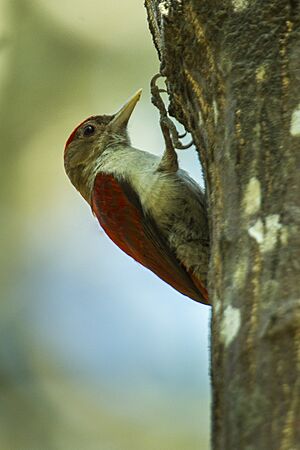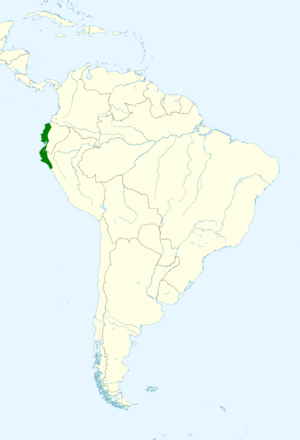Scarlet-backed woodpecker facts for kids
Quick facts for kids Scarlet-backed woodpecker |
|
|---|---|
 |
|
| Conservation status | |
| Scientific classification | |
| Genus: |
Veniliornis
|
| Species: |
callonotus
|
 |
|
| Synonyms | |
|
|
The scarlet-backed woodpecker (Veniliornis callonotus) is a colorful bird. It is a type of woodpecker found in South America. You can see this bird in countries like Colombia, Ecuador, and Peru.
Contents
About This Woodpecker
Scientists group animals based on their features. The scarlet-backed woodpecker is part of the Veniliornis group. Some scientists, like the American Ornithological Society, decided to move all birds from Veniliornis into a different group called Dryobates. This change happened in 2018.
There are two main types, or subspecies, of the scarlet-backed woodpecker:
- V. c. callonotus
- V. c. major
What Does It Look Like?
The scarlet-backed woodpecker is a small bird. It is about 13 centimeters (5 inches) long. It weighs between 23 and 33 grams (0.8 to 1.2 ounces).
Males and females look very similar. The main difference is on their heads.
- Both sexes have a grayish-brown and white face.
- Male woodpeckers have a bright red head from their forehead to the back of their neck. Some of these red feathers have black tips.
- Female woodpeckers have an all-black head in the same area.
The top part of their body is a brownish-scarlet color. Their flight feathers are dark brown. The tail is blackish-brown. The feathers in the middle of the tail are darker. The outer tail feathers are yellowish-white with black stripes.
Their belly and chest are white with a very light yellowish tint. Sometimes, you might see faint, wavy dark lines on their underside. Their eyes are dark brown, but sometimes deep red. The beak is yellowish with a darker tip and base. Their legs are greenish-gray.
Young woodpeckers look a bit different. They have olive or grayish spots on their upper parts. Their undersides are more yellowish-white. Their head patterns are not as clear as adult birds. The V. c. major subspecies has a darker face. It also has more noticeable wavy lines on its belly than the V. c. callonotus type.
Where Do They Live?
The V. c. callonotus subspecies lives in western Ecuador. It is found from Colombia's Nariño Department south to Guayas Province.
The V. c. major subspecies lives further south. You can find it from El Oro and Loja provinces in Ecuador. It also lives in Peru, as far south as La Libertad Department.
This woodpecker likes to live in dry areas. Its homes include:
- Dry scrublands
- Dry forests where trees lose their leaves
- Forests that are a bit humid
- Thick forests near rivers (called riparian forests)
- Sometimes, areas where some trees have been cut down
They usually live from sea level up to about 1,000 meters (3,300 feet) high. Sometimes, they can be found higher, up to 1,500 meters (4,900 feet) in Peru. In Ecuador, they can even live as high as 1,800 meters (5,900 feet).
How Do They Behave?
Movement
The scarlet-backed woodpecker stays in the same area all year round. It does not migrate.
Feeding Habits
This woodpecker looks for food at all levels of the forest. It often searches on small branches and thin twigs. They are often seen feeding in pairs. Scientists do not know much about what they eat.
Reproduction
We do not know much about how scarlet-backed woodpeckers raise their young. We know that their breeding season includes July in Ecuador. More research is needed to learn about their breeding habits.
Vocalizations
The most common sound this woodpecker makes is a rattling call. This call lasts for one to two seconds. They also make a sharp "ki-dik" sound. Sometimes, they repeat this sound quickly in a short series.
What Is Their Status?
The IUCN (International Union for Conservation of Nature) has looked at the scarlet-backed woodpecker. They have listed it as a species of "Least Concern." This means it is not currently in danger of disappearing.
The bird lives across a large area. Even though we do not know the exact number of these birds, their population is thought to be growing. There are no major threats to them right now.
The scarlet-backed woodpecker seems to be rare in Colombia. However, it is quite common in Ecuador and Peru. It lives in some protected areas in these countries. In Ecuador, it has even started to move into more humid areas. This might be because of deforestation, which means trees have been cut down.


